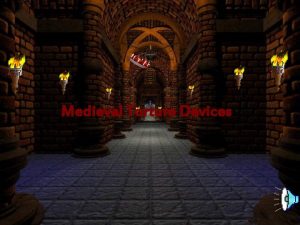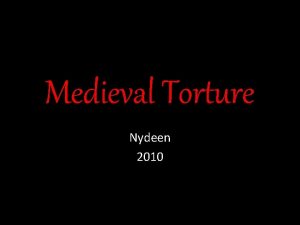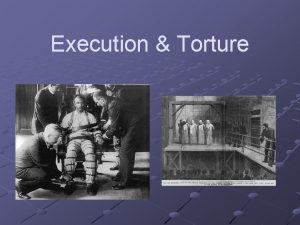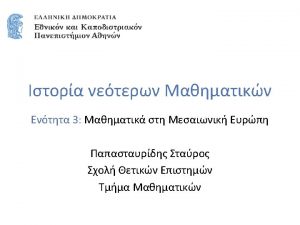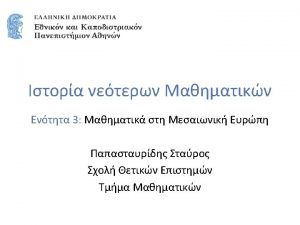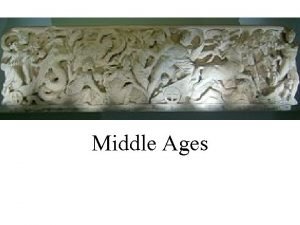Middle Ages Torture The Medieval period of the














- Slides: 14

Middle Ages Torture The Medieval period of the Middle Ages was violent and blood thirsty. In barbarous times the cruel and pitiless feeling which induced legislators to increase the horrors of tortures, also contributed to the aggravation of the fate of prisoners. Torture chambers were included in many castles. Law or custom did not prescribe any fixed rules for the treatment of hapless prisoners who faced torture. Different types of torture were used depending on the victim's crime and social status. Torture was seen as a totally legitimate means for justice to extract confessions, or obtain the names of accomplices or other information about the crime. Torture was a legitimate way to obtain testimonies and confessions from suspects for use in legal inquiries and trials during the Middle Ages. Facts and information about various forms of tortures and executions can be accessed from the following links:

The pillory was used to publicly humiliate a victim. Even though it was meant as a mild form of punishment, the crowd sometimes made it lethal. The pillory often served as a post for Flagellation. When the victim was restrained with the device, he was completely defenceless and subject to the crowd. In many cases the crowd threw harmless objects such as vegetables, but when the victim committed a serious offense they threw stones or other heavy objects. The crowd often humiliated the victim by cutting his hair, putting marks on his body and even mutilating some of his body parts. The pillory didn't last more than a few hours, but it was sometimes carried on for days. The device was situated in either the marketplace or the plaza - where most villagers could see the victim's suffering. The army was also well-known for using the pillory as a means of punishment

The victim's feet were imprisoned in the stocks (see picture) and then red-hot coal was placed right under them. When the subject was interrogated, a screen was put between the heat and his feat, acting as relief. If he refused to confess, his bare feet were exposed to the flames. The torture progressed until the victim's feet were charred to the bone. When this occurred, the phalanges and other bones fell as the feet were completely burned. This very rarely resulted in death, but if the victim refused to confess, he could be subject to other tortures

Dunking is a form of punishment that was mainly reserved for supposed witches. The victim was tied to a chair which was elevated or lowered by the torturer. If he noticed that the victim was going to pass out, he elevated the chair. When he needed information and the victim was unwilling to cooperate, he lowered it. This method was widely used during the Spanish Inquisition and in England France. The victim was usually intermittently submerged for many hours until he or she revealed information or death occurred. While witches were commonly tortured using this method, thieves and murderers could be subject to it in order to extract a confession. This was more common when other more sophisticated torture devices were not present.

Drops of Water A very painful method of torture consisted of fixing a victim's head under a small tube that constantly filtered drops of water. These fell on the same spot of the victim's head leading to, in prolonged periods of time, perforation and eventually death. The Cauldron The unlucky victim was placed inside an empty cauldron attached to chains. The cauldron was filled with cold water and beneath it, a fire was set. Eventually the water began to boil cooking the victim alive. This was more frequently a way to execute a prisoner rather than to extract a confession. Freezing with water In the winter, the naked victim was forced to stand outside in full view of everyone. Slowly, the torturer poured water on his head which eventually became frozen making the victim die slowly and painfully. Sometimes the body was left for the whole winter to terrify the population and dissuade any further crimes, as punishment was imminent. Force Drinking This torture was mostly used in more recent times, but some historians believe that its origins date to the Middle Ages. The effect is this: the victim is forced to drink much water until his confession or death

The victim's fingers were placed inside the instrument and slowly crushed as the torturer turned the handle on top. This method was primarily used to extract confessions as it was both painful and very lasting. If the victim refused to speak, the torturer could choose from many other torture methods. The same instrument was also used to crush victim's toes. A bigger variant of the instrument that followed the same principle was used to crush victim's feet, knees and elbows. The Head Crusher was used for crushing the head.

The head crusher was widely used during most of the Middle Ages, especially the Inquisition. With the chin placed over the bottom bar and the head under the upper cap, the torturer slowly turned the screw pressing the bar against the cap. This resulted in the head being slowly compressed. First the teeth are shattered into the jaw; then the victim slowly died with agonizing pain, but not before his eyes were squeezed from his sockets. This instrument was a formidable way to extract confessions from victims as the period of pain could be prolonged for many hours if the torturer chose to. This could be done by repeatedly turning the screw both ways. If the torture was stopped midway, the victim often had irreparable damage done to the brain, jaw or eyes. Many variants of this instrument existed, some that had small containers in front of the eyes to receive them as they fell out of their sockets.

The knee splitter, a terrible torture, was mostly used during the Inquisition. What this instrument accomplished was to permanently render the knees useless. Even though the name implies that this instrument was only used for "splitting" knees, it was also used in other body parts including: the elbows, arms and even the lower legs. As the torturer turned the handle, the claws slowly slammed against each other mutilating any skin in between. The number of spikes the knee splitter contained varied from three to more than twenty. There were many variants to this instrument. Some claws were heated beforehand to maximize pain others had dozens of small claws that penetrated the flesh slowly and painfully. Even though this method very seldom provoked direct death, it was often followed by other more painful methods if the victim refused to cooperate.

A cheap and effective way to torture someone was with the use of rats. There were many variants, but the most common was to force a rat through a victim's body (usually the intestines) as a way to escape. This was done as follows: The victim was completely restrained and tied to the ground or any horizontal surface. A rat was then placed on his stomach covered by a metallic container. As the container was gradually heated, the rat began to look for a way out - through the victim's body. Digging a hole usually took a few hours of agonizing pain for the victim. This almost invariantly resulted in death.

The rack is commonly considered the most painful form of medieval torture. It was a wooden frame usually above ground with two ropes fixed to the bottom and another two tied to a handle in the top. The torturer turned the handle causing the ropes to pull the victim's arms. Eventually, the victim's bones were dislocated with a loud crack. If the torturer kept turning the handles, some of the limbs were torn apart, usually the arms. This method was mostly used to extract confessions, as not confessing meant that the torturer could stretch more. Sometimes, torturers forced their victim to watch other people be tortured with this device to implant psychological fear. Sometime this method was limited to dislocating a few bones, but the torturer often went too far and rendered the legs or arms (sometimes both) useless. In the late Middle Ages, some new variants of this instrument appeared. They often had spikes that penetrated the victim's back - as the limbs were pulled apart, so was his spinal cord increasing not only the physical pain, but the psychological one of being handicapped at best, too.

The Coffin Torture was feared throughout the Middle Ages. It is enough for one to look at the picture to the left to realize the reason. The victim was placed inside the "coffin". Torturers were well-known forcing overweight victims into the device, or even making the "coffin" slightly larger than normal to make the victims more uncomfortable. The period of time a victim was to be kept inside the coffin was determined by his or her crime. Very serious crimes, such as blasphemy, were punished by death inside the coffin where the victim was to be kept inside under the sun with animals eating his or her flesh. The coffin was sometimes placed in a public plaza so the local population would congregate around it and mock the unlucky victim. Sometimes death occurred because of the hatred towards the person as others often threw rocks and other objects to further increase the pain.

The Iron Maiden, otherwise known as the Virgin of Nuremberg, was a device used from the XVI century to torture criminals. It stands 7 feet tall and is able to accommodate a man. The victim was tied inside the Maiden and one of the two doors was shut, penetrating the victim's flesh with the strategically-placed spikes that didn't penetrate any vital organs. When completely closed, the screams from the victim could not be heard outside, nor could the victim see any light or hear anything. This increased the psychological pain. Additionally, the spikes blocked the wounds so it took many hours - or even days - for death to occur. If the door was opened, the victim would stand in the exact same position so if the torturer chose to close the door again, the spikes would penetrate the exact same wounds. Sometimes the door was intermittently closed to maximise the victim's pain without delivering death.

There are many variants of the chair. They all have one thing in common: spikes cover the back, arm-rests, seat, leg-rests and foot-rests. The number of spikes in one of these chairs ranges from 500 to 1, 500. To avoid movement, the victim's wrists were tied to the chair or, in one version, two bars pushed the arms against armrests for the spikes to penetrate the flesh even further. In some versions, there were holes under the chair's bottom where the torturer placed coal to cause severe burns while the victim still remained conscious. This instrument's strength lies primarily in the psychological fear caused on the victims. It was a common practice to extract a confession by forcing the victim to watch someone else be tortured with this instrument. The time of death greatly varied ranging from a few hours to a day or more. No spike penetrated any vital organ and the wound was closed by the spike itself which delayed blood loss greatly.

Judas Cradle The Judas Cradle, a terrible medieval torture where the victim would be placed on top of a pyramid-like seat. The victim's feet were tied to each other in a way that moving one leg would force the other to move as well - increasing pain. The triangular-shaped end of the judas cradle was inserted in the victim's anus or vagina. This torture could last, depending on some factors discussed below, anywhere from a few hours to complete days. Death Factors The time it took someone to die varied enormously from individual to individual. Torturers would sometimes add weight to the victim's legs as to increase pain and hurry the victim's death. Other torturers would place oil on the device which increased pain considerably. This device was rarely, if at all, washed. If the victim did not die quickly enough, or their painful execution was interrupted, they would invariantly die from an infection. The victim was sometimes rocked or made fall repeatedly onto the "pyramid". This was done so torturers could acquire vital information from the victim. If he or she refused to talk, the torturer would either add more weight to the victim or make him or her fall repeatedly on the device.
 Dark ages def
Dark ages def Dark ages vs middle ages
Dark ages vs middle ages Egyptian floral design history
Egyptian floral design history Pear of anguish definition
Pear of anguish definition Hierarchy middle ages
Hierarchy middle ages Middle ages floral design
Middle ages floral design Middle ages art characteristics
Middle ages art characteristics Early middle ages
Early middle ages The middle ages spans nearly one thousand years.
The middle ages spans nearly one thousand years. Early middle ages
Early middle ages Middle ages unit test answers
Middle ages unit test answers Education in middle ages
Education in middle ages High middle ages
High middle ages The middle ages 1066 to 1485 unit introduction
The middle ages 1066 to 1485 unit introduction 450/1750
450/1750



